Following text and photos by Scott Lessing Hubener.
The 19/23 corridor
I have completed a recent body of work tentatively titled, The 19/23 Corridor, which is a photo documentary of the area between Asheville, NC and Johnson City, TN where a stretch of the 19/23 highway lies. This project has taken almost a year to complete and is one of the largest projects I’ve undertaken in terms of commitment of time and scale of coverage. I’ve chosen to discuss this work in particular, as it is representative of my style and approach as a photographer and artist. Below is a statement and description of the project, followed by insights into my approach and the general execution of producing the photographs.
Between Asheville, NC and Johnson City, TN lie sixty miles of varying geography, topography and demographics. Both Asheville and Johnson City are modestly sized urban areas with populations of approx 70,000 and 55,000 respectively. However, the counties between the two are some of the least populated and most rural of North Carolina and Tennessee. Madison County in NC and Unicoi county in TN epitomize the rural, quiescent, bygone eras and slower pace of life; a life that has for centuries depended upon the land for its survival and that in many ways continues to this day. As one follows the path of highway 19/23, the corridor that includes Interstate 26 and Future Interstate 26, there is a colliding and blending of past, present and future. Even the road’s varied name and status reflects this.
The roadway connecting these two cities serves as a symbol and a theme both literally and figuratively. Much as a river’s basin hosts the life along its banks and serves as a transporter of goods, people and commerce, so too does the 19/23 corridor. Along the roads and highways adjacent to the corridor, the true character of the region can be found; a region dotted with churches and crosses, barns, farms and livestock. I find the highway corridor a metaphor, because of its scale, wide reaching and meandering path, to be that of a great river and the tie that binds the region, connecting the cities, cultures and commerce of entire region.
I am interested in the dichotomy and disparate realities that span the 19/23 corridor. This spanning of the spectrum is analogous of the interstate itself, of progress vs. nature, development vs. conservation. Country barns and plowed farmland lie in the shadow of modern engineering marvels such as the viaducts and towering overpasses of the interstate and highway, which hug the mountainside. The cities of Asheville and Johnson City continue to grow as the infrastructure develops and the ease of travel and the movement of commerce is unimpeded. While the mountains of the Blue Ridge aren’t the most formidable peaks known to man, they do however insulate and dominate the landscape. Development in this region has been limited by the rough geography, however the coves and valleys do afford a spot for settlement and many of them have been occupied by families for several generations. The region boasts a population of which a majority were born and raised within the shadow of its mountains. Conversely the urban cities of Asheville and Johnson City tend to grow and expand their populations by attracting new residents from other locales. These disparities reflect the dichotomy of life and contribute to the richness and complexity of existence, which is really what this work is about, the richness of life.
As far as my method for creating images, I’ve detailed some background and insight into my approach and decision-making. My photographs are made primarily using natural or ambient light. This is one element that gives my work the feel and mood it possesses. I enjoy the evenness and honesty that I get from working with natural light. I prefer diffused, even lighting to harsh lighting; the diffused light to me is more truthful and the colors can compete for attention of the viewer in a balanced manner. My work is shot on portrait film for realistic, natural tones and colors. Using color film is important for me, as color brings another element, another layer and depth to the images. Even if the color is subtle, its presence is significant. I think the use of color adds a greater artistic element than just black and white images would to my work. The photos I produce, are in my mind, documentary first and then secondly art. I do concede there is an artistic value and merit to my work and I do strive towards that, but it is not my first intention or purpose.
Another technical insight into this series is that I have photographed it entirely with a medium format Hasselblad camera. I love what the format has to offer me; the larger negative is great for capturing detail and yet it is light enough to occasionally handhold and is less obtrusive than a large format camera. The Hasselblad’s use of roll film enables a few shots of a particular subject, whereas a larger format camera would also limit my exposures drastically to just a single frame. In some of my images, I consciously include a lot of information within the frame, and knowing that I have the resolving power of the larger negative to hold onto that information in the print is very important. I don’t want the detail to be lost in the print. I prefer a medium sized print for this series, and the photos are all printed at a 20″x20″ size. I also prefer the Hasselblad’s square image to that of a rectangular shape. The balance of the photos in a square image is much different than other formats and I enjoy the challenges and frankness the square image holds. One thing I admire so much about documentary photography is the straightforwardness in the presentation and depiction of the subject. I don’t go in for unusual angles or abstract subject matter. Attempting to be as truthful with the subject as possible is my goal. The lens I use most often is an 80mm, which is the normal lens for the format. Occasionally I use a 65mm, which is slightly wider, but still a modest wide angle and without distortion.


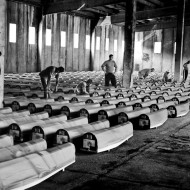
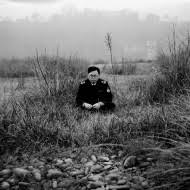
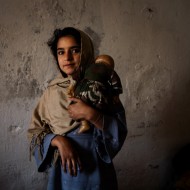
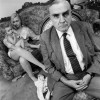
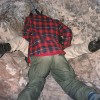











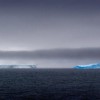

















You can also subscribe to this post comments RSS feed.